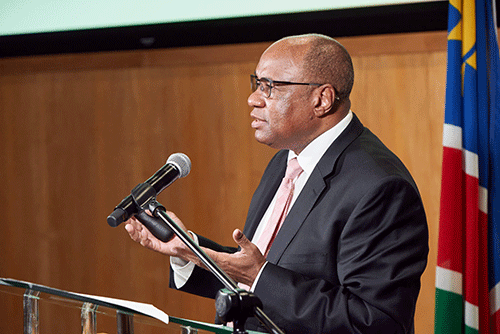Namibians were yesterday slapped heavily after the Bank of Namibia governor Johannes !Gawaxab announced that the repo rate has increased by 50 basis points, from 7.25% to 7.75% with immediate effect. Bringing the prime lending rate to 11.50%.
“Not acting and failing to live up to our constitutional mandate, the alternative is going to be worse for the majority of Namibians. And it’s going to affect Namibians more than what they are seeing at this point in time,” said !Gawaxab during the third monetary policy announcement of the year.
The increase will severely impact Namibian consumers who rely on debt to survive.
The repo rate is defined as the lending rate offered by a central bank to commercial banks for its short-term funding requirements. The commercial banks then pass on the interest rate levied by the central bank to their consumers through interest charges on loans.
However, the governor noted this is not a permanent situation. He further urged consumers to change their spending behaviours due to unfavourable interest rate environment.
!Gawaxab stated the increase was to continue safeguarding the one-to-one link between the Namibian Dollar and the South African Rand.
It is simultaneously aimed at further containing inflationary pressures, stemming their associated second-round effects and anchoring inflation expectations.
Commenting on the increase, Capricorn Asset Management chief economist Floris Bergh advised consumers to be very hesitant to incur debt in a rising interest rate environment.
“Rather seriously attempt to save at these beneficial rates, which means the postponement of consumption. In a broader sense, this means having a savings mindset, looking for investment assets that benefit from the shifting landscape such as higher interest rates and a weakening currency,” advised Bergh.
Repossessions
The governor stated there is a lot of empathy from the central bank for people losing houses and the bank is concerned.
“The Covid-19 relief measures assisted many people that would have been without houses today. The banks are informing us that they are trying to do everything they can but it’s not good enough. So we as a nation need to look at better solutions to keep more Namibians in their homes, we are very supportive of that initiative to keeping more Namibians in the homes within the culture of financial stability,” he added.
In a recent response to New Era, concerning the escalating cost of debt, Bankers Association of Namibia (BAN) CEO Brian Katjaerua noted banks have been assisting their customers during these trying times.
Earlier, BAN emphasised that home foreclosure is the absolute last step, considering banks’ overall intent to keep owners in their houses rather than the opposite.
Meanwhile, according to the financial stability report for 2022 released by the Bank of Namibia (BoN) and the Namibia Financial Institutions Supervisory Authority (Namfisa), households’ debt servicing costs almost doubled from 2020 to 2022.
“The household debt servicing costs increased from 9% in 2020 to 17.8% in 2022, reflecting a combination of higher debt levels as well as high-interest rates. Although households are highly indebted, the majority of their debt is secured lending, of which mortgage lending accounts for most of it,” reads the financial report.
The household sector in Namibia accounts for the majority of private sector credit extended (PSCE). It is, therefore, an important participant in the domestic financial system, accounting for almost 58% of total private sector credit extended by the banking sector over the past five years.
Weighing in on the increase, the Economic Association of Namibia (EAN) said higher interest rates can affect the affordability of new loans. It becomes more expensive for individuals and businesses to borrow money, which can lead to a decrease in demand for credit. This reduction in borrowing and spending can have a dampening effect on economic growth, as consumption and investment may slow down, added EAN.
Currency depreciation
At the same occasion, the central bank head noted there is a need for people to understand what is really driving inflation.
“The big thing that we should be worried about is if there is a further depreciation of the South African Rand, it poses risks to inflation, and how long we can get the repo low. The Rand and Namibia Dollar has depreciated by about 12% against the US dollar, while being undervalued by about 20%,” said !Gawaxab.
He noted the depreciation is likely driven by activities in the South African economy like the greylisting, load shedding and the South African-Russia relationship that continues to impact the exchange rate.
Hitting on economists
The governor did not filter his words, as he disagreed that interest rates are supply driven, and it is not going to do the trick.
“We totally disagree with that. In as much as we agree that interest rate is a tool that is best suited to deal with demand driven inflation, what we are trying to do here is to safeguard the peg. We are in a fixed exchange regime with South Africa, we cannot have a 2% or 3% differential because we are creating many arbitrage opportunities,” said !Gawaxab.
Earlier this week, Professor Teresia Kaulihowa from the Namibia University of Science and Technology (NUST) argued that raising interest rates would be ineffective in addressing the root cause of inflation because it primarily focuses on demand-side factors.
Instead of relying on monetary policy tools like interest rate hikes, other fiscal policy measures to address supply-driven inflation can be used to address supply constraints (targeted sectoral support) more so for countries not under a currency board operations arrangement.
“It emphasises the importance of aggregate demand in driving economic growth and believes that changes in aggregate demand have a more significant impact on the economy than changes in the money supply or interest rates,” she stated.


